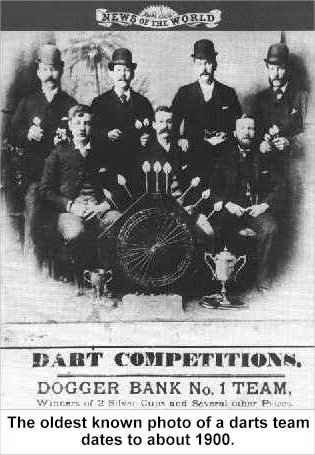Most accounts say that the sport of darts began sometime in the Middle Ages, when archers threw cut-down arrows at a target as a way of practicing indoors.
Dan William Peek disagrees. In his entertaining and informative book, To The Point: The Story of Darts in America, he details his extensive research, which failed to turn up any legitimate references to darts as a game before the 19th century, and precious few before the 20th century.

Those other writers tend to lean on Anne Boleyn’s gift of “dartes” to Henry VIII in 1530. But “darte” back then was usually a synonym for “arrow.” There are many poetic references to Cupid’s darts and Cupid, of course, is always pictured with a bow and arrow. There’s no dartboard in sight.
Evidently, there was a game in the 19th century called Puff and Dart, in which a blowpipe was used. There’s an account of a player who, in 1844, died of internal injuries after he inhaled instead of blowing. But it’s impossible to determine the provenance or truth of that story.
It also appears that darts may have originated at English fairs later in the century, though the evidence is meager. The game’s unusual numbering sequence is credited to Brian Gamlin, a carpenter from Bury, Lancashire, who designed and made a board for a fairground in 1896. Gamlin never patented the arrangement. Reportedly, he died in 1903, at the age of 51, but no record has ever been found of his death, or of his existence, for that matter.
When we enter the 20th century, the historical record finally becomes clearer. In 1904, “Dart and Target” was listed among games that could lawfully be played on licensed premises, basically meaning pubs. That game used a kind of scaled-down archery target, with a bullseye surrounded by concentric scoring circles.
But the modern game of pub darts, with its unusual scoring system, had been pretty well established by 1908, because in that year a Leeds pub owner known as “Foot” Anakin was hauled into court on the charge of operating a game of chance, namely darts. Anakin’s defense was that darts was a game of skill. He brought in a dartboard, demonstrated by throwing three triple twenties, and the case was dismissed.
By the 1920s, darts had become well established as a popular pub sport in Great Britain. The National Darts Association (NDA) was founded in 1924 to govern the sport and sanction major competition.
The first important tournaments were sponsored by newspapers. The News of the World began conducting a tournament for the Metropolitan Area of London in the 1927-28 season, and gradually added other regions. A crowd of 14,534 spectators packed London’s Royal Agricultural Hall to watch the final match of the 1939 London and South of England championship.
The People newspaper established the Lord Lonsdale Trophy for six-a-side team competition in 1938. That event was taken over by the NDA in 1962.
Major competition was suspended because of World War II, but the News of the World kept the sport in the public eye by organizing a team that played exhibitions to raise money for the Red Cross and other charities. During the war, British servicemen introduced English pub darts to Americans, Australians, New Zealanders, and others, helping to set the stage for post-war international expansion.
However, that expansion didn’t really begin until the early 1970s, mainly because of an Englishman named Olly Croft. He organized the British Darts Organisation (BDO) in 1973 and the World Darts Federation (WDF) in 1976. The WDF established the first true world championship tournament in 1979, under the sponsorship of Embassy, an equipment manufacturer. The event was known as the Embassy World Championship until 2004, when the Lakeside Country Club took over sponsorship. In the meantime, the champion’s prize has grown from £3,000 to £50,000.
Starting with 15 countries, the WDF now has about 50 member nations on six continents. In addition to the Lakeside World Championship, the organization stages several biannual events, including the World Cup, Asia Cup, Europe Cup, and Pacific Cup.
Sixteen top players, led by Phil “the Power” Taylor, left the BDO to form a rival group, the Professional Darts Council (PDC) in 1992. The PDC has staged its own world championship since 1994. Phil Taylor has won nine of the twelve titles. Other major PDC tournaments are the UK Open, the Stan James World Matchplay, the Las Vegas Desert Classic, and the Paddy Power World Grand Prix.
Darts History
- British Style Darts
- American Style Darts
- The British Invasion
